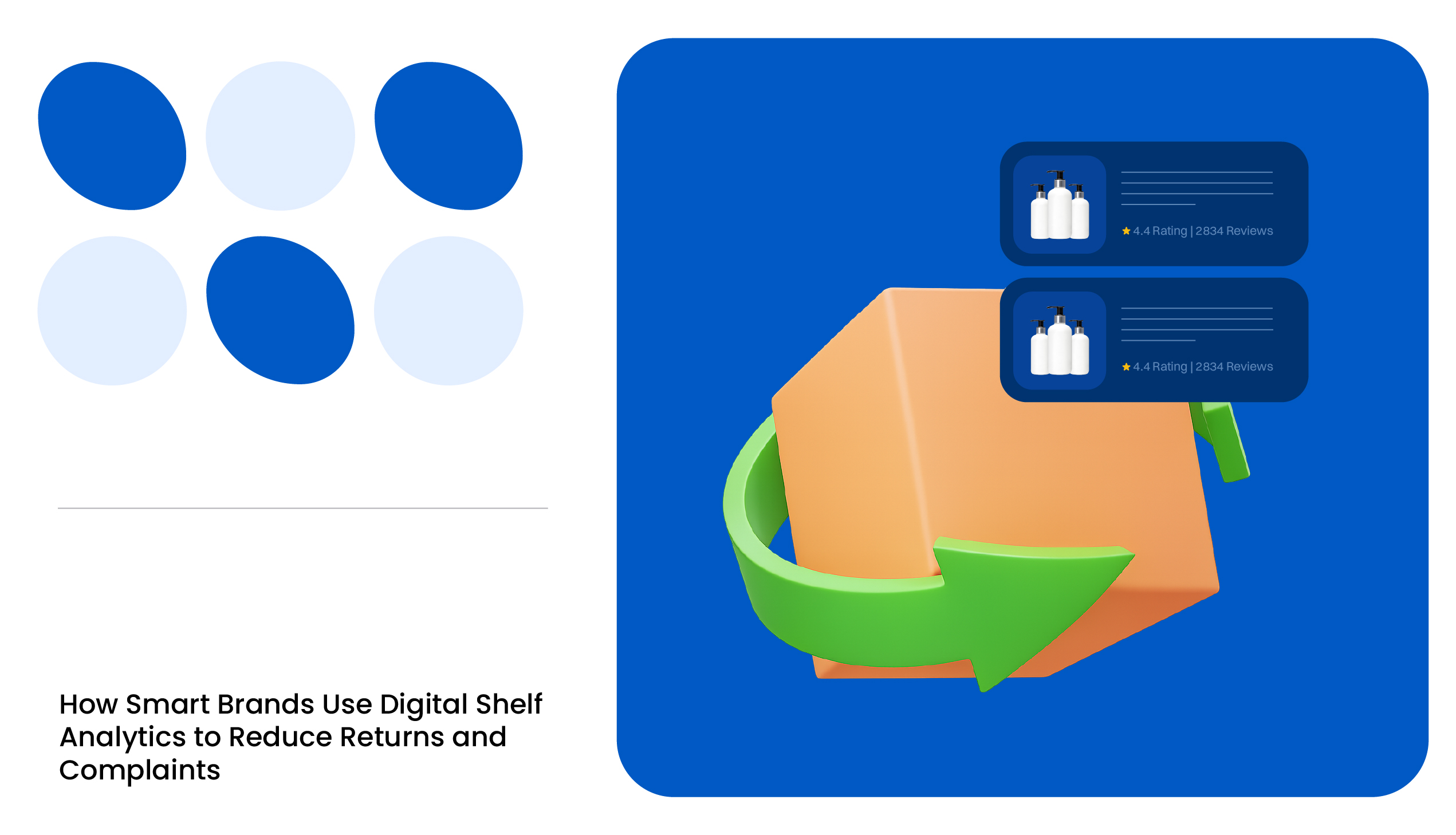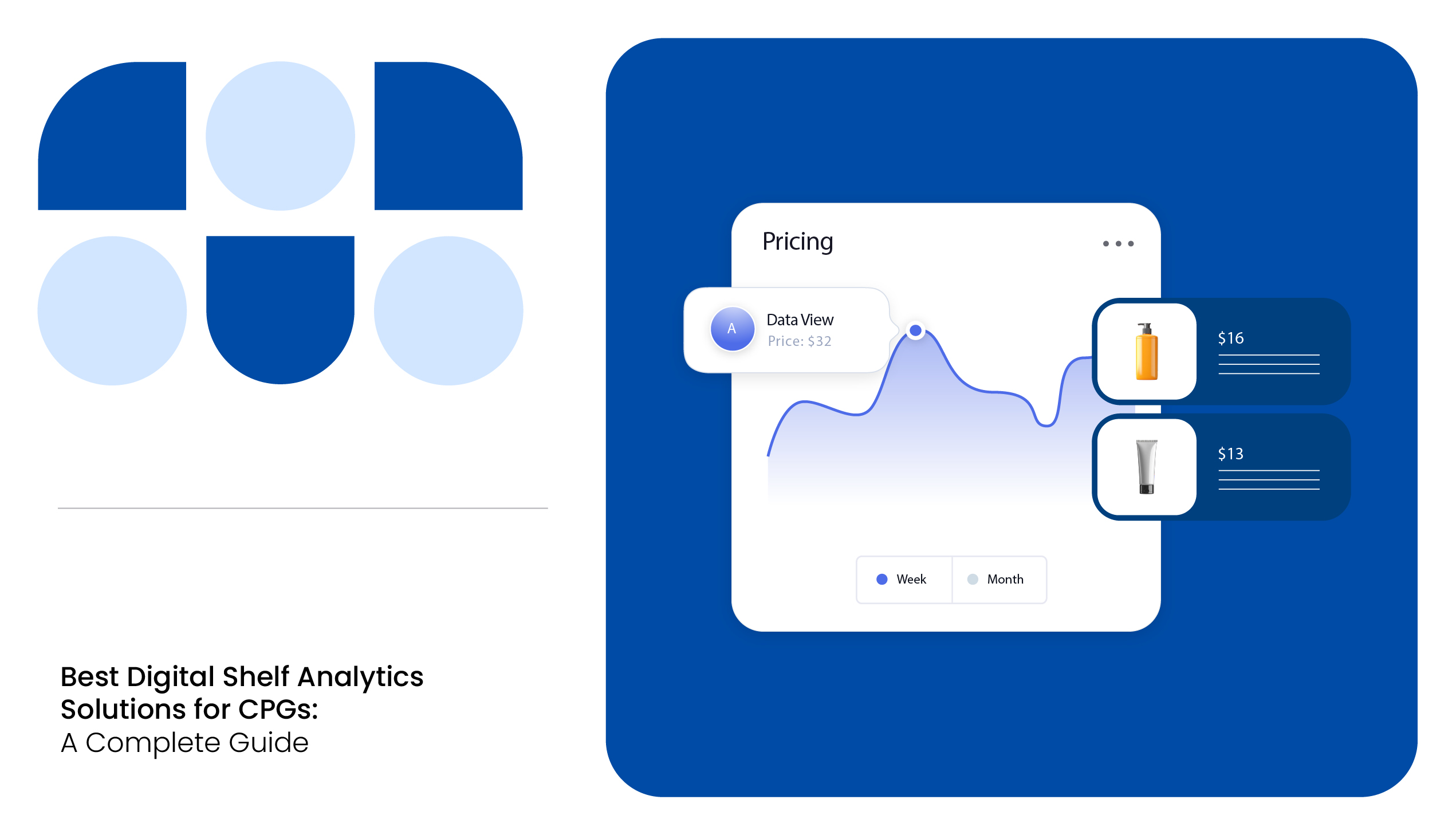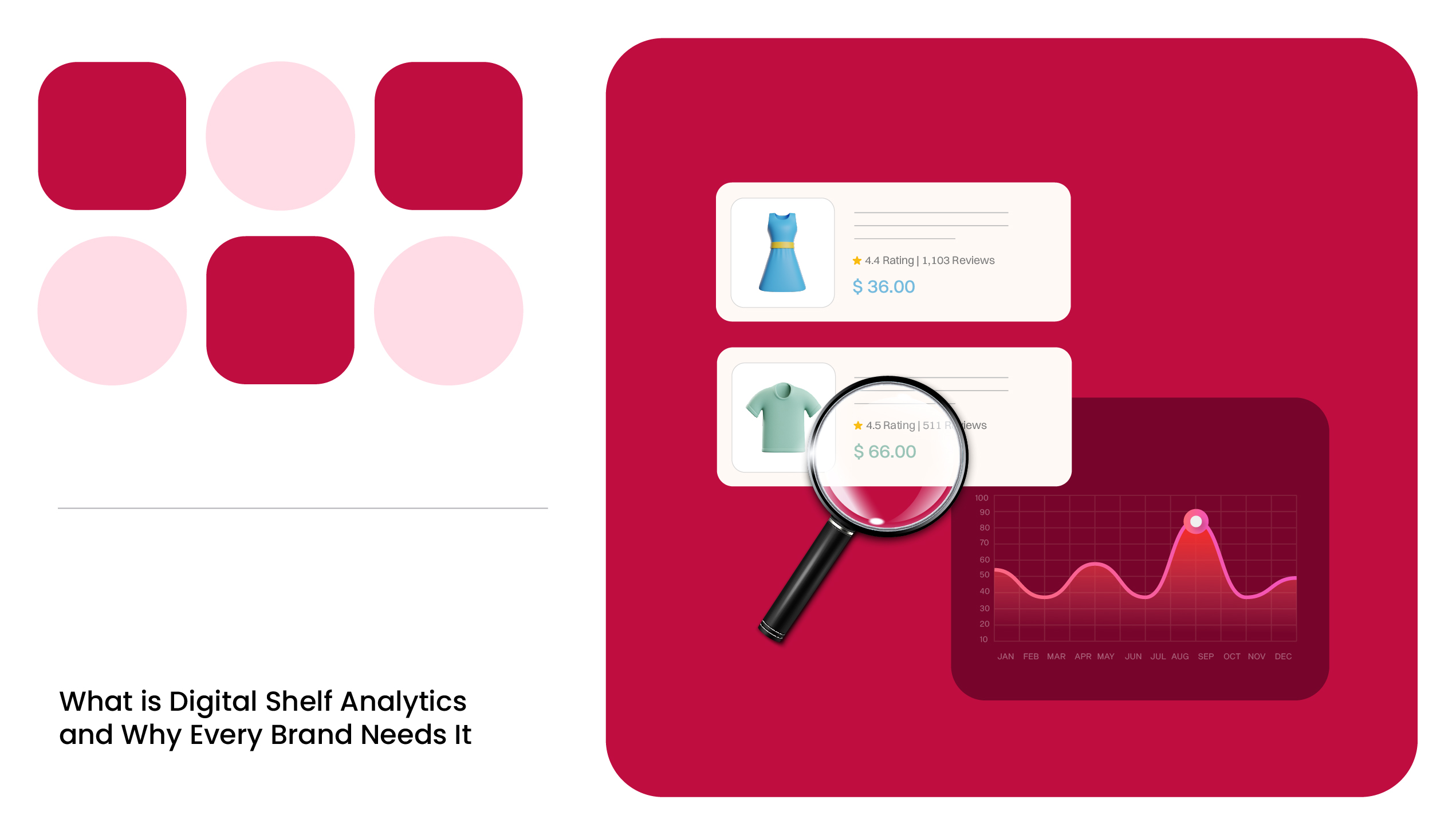Alright, let’s get real for a second: you’re trying to win on Amazon, right? Maybe your brand is crushing it in some areas but not quite getting that Buy Box, or perhaps you’re getting lost in the crowd on search results.
Either way, you’ve probably heard about Amazon A9 algorithm, the secret sauce that decides which products show up where. The A9 algorithm interprets consumer behavior on Amazon and decides which products should come up in the search results based on multiple factors.
Currently, Amazon has about 9 million total sellers and around 2 million active sellers trying to compete for the Buy Box for multiple product categories.
Whether you’re a brand manager, purchase manager, or part of an e-commerce team, understanding how to crack Amazon’s algorithm can be the game-changer your brand needs.
Third-party digital shelf analytics software can help you optimize and track important metrics, opening up new frontiers in your e-commerce business.
Let’s cut to the chase and dive into what the Amazon A9 algorithm is, how it works, and, more importantly, how you can make it work for your brand to win the Buy Box and climb those rankings on Amazon.
Amazon A9 Algorithm Explained for Sellers & Brands
To put it in the most basic terms, Amazon’s A9 algorithm is the brain behind the massive e-commerce machine. When someone types a search query into Amazon’s search bar, it’s the A9 algorithm that decides which products to show, in what order, and why.
Unlike Google, which shows a mix of ads, links, and content, Amazon’s algorithm is laser-focused on sales. It wants to show products that are most popular among customers and are bought frequently.
The A9 algorithm is about relevancy and performance. It’s constantly evolving and analyzing millions of products, sales trends, customer reviews, seller metrics, etc., providing consumers with the best experience using Amazon.
If you understand what A9 is looking for, you can optimize your listings to match, boosting your chances of getting your products in front of potential buyers and, of course, winning that Buy Box.
How Does Amazon’s A9 Algorithm Work?
Amazon does not reveal the actual working criteria of the A9 algorithm as it is a proprietary tech developed by the e-commerce retail giant. However, some of its central characteristics could be decoded.
Amazon makes its money when you make sales. Therefore, Amazon’s A9 algorithm prioritizes products that it believes are most likely to sell. Hence, it uses two broad categories of data to make these decisions: performance factors and relevance factors.
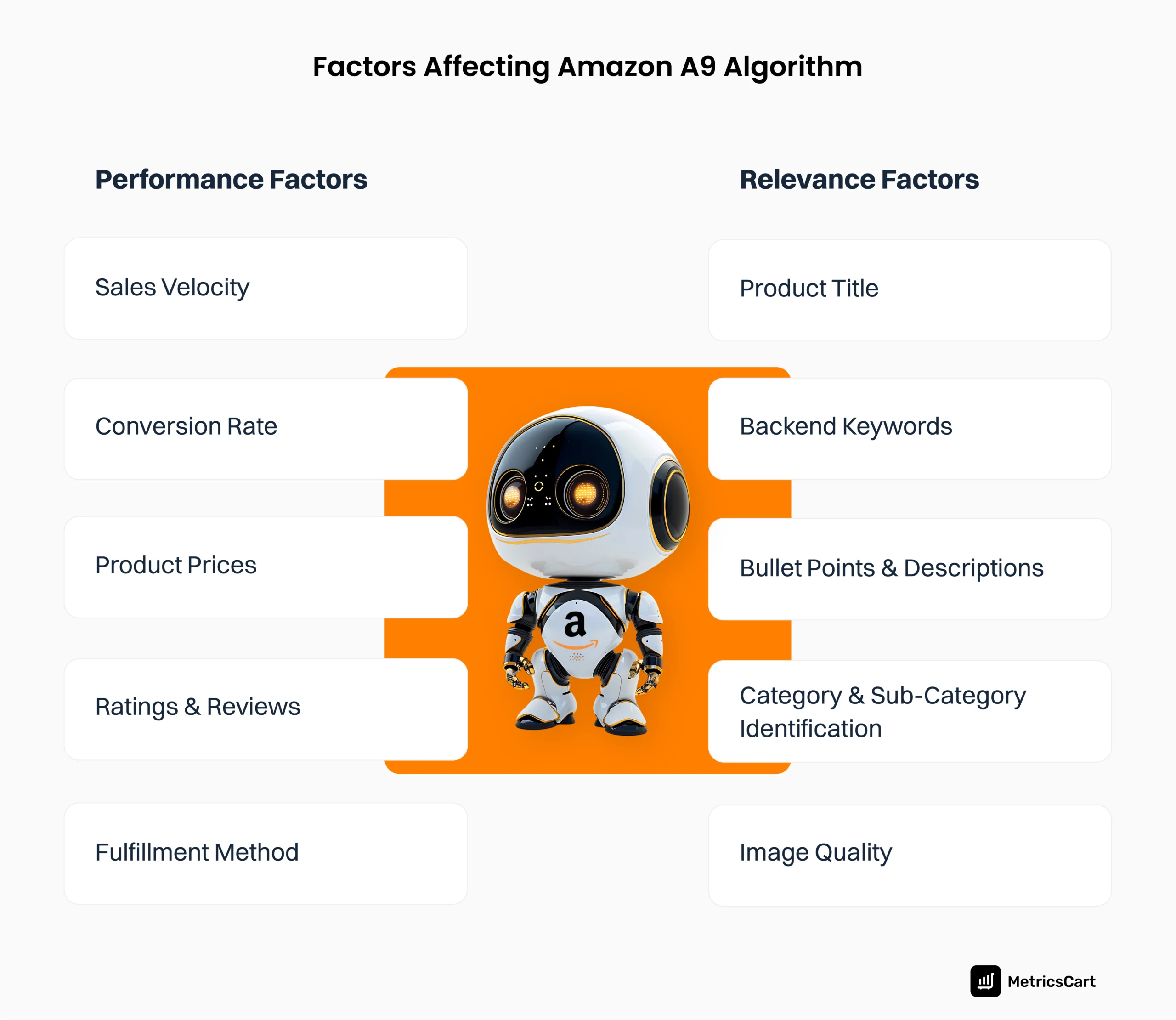
Performance Factors
When it comes to Amazon’s A9 algorithm, performance factors are at the heart of how your product ranks. These are the data points Amazon cares about the most and are about showing products that are most likely to sell.
In other words, if your product is moving fast, priced competitively, and earning rave reviews, A9 will boost your ranking. Let’s break down these performance factors you need to focus on.
Sales Velocity
The faster and more frequently your product sells, the higher Amazon will rank it. Amazon loves products that fly off the shelves. So, it becomes the responsibility of brands or sellers to design their sales strategy to attract customers to their product offerings.
Conversion Rate
How many people visit your product page and actually make a purchase? A high conversion rate tells Amazon that people like your product, which boosts your ranking.
Product Price
Competitive pricing is essential. If your product is significantly more expensive than similar products, A9 will deprioritize it. You need to strike a balance between competitive pricing and profitability.
Customer Reviews and Ratings
Products with high ratings and plenty of reviews tend to rank higher on Amazon. Social proof and authentic reviews from other customers reassure Amazon that your product is trustworthy.
Fulfillment Method (FBA vs. FBM)
Amazon heavily favors products fulfilled through Fulfillment by Amazon (FBA) because FBA ensures faster shipping and better customer service.
However, if you’re using Fulfillment by Merchant (FBM), you may face more challenges in ranking higher unless you have stellar shipping metrics.
READ MORE | What are the best Amazon price trackers available in the market right now? Check out our new blog on Amazon Price Tracker You Need in 2024: A Seller’s Guide
Relevance Factors
While performance factors measure how well your product is selling, relevance factors determine if your product matches what customers are searching for.
These are the elements that tell Amazon whether your product is the right fit for a specific search query. From well-optimized titles and descriptions to the appropriate use of keywords and high-quality images, relevance factors ensure your product shows up in the right searches.
To get your product in front of potential buyers, you need to nail these relevance signals:
Product Title
This is one of the core aspects of product ranking. Your product title should include high-priority keywords that people are actually searching for. Don’t go overboard with keyword stuffing because A9 is smart enough to know when a title becomes unreadable.
Backend Search Terms
Amazon allows you to include keywords in the backend of your listing that aren’t visible to customers but are used by A9 to index your product. This is your chance to include misspelled words, synonyms, and related terms that potential buyers might search for.
Bullet Points and Descriptions
Make sure your bullet points and descriptions not only describe your product but also hit the right keywords. The more relevant your description is to the customer’s search query, the higher your product will rank.
Category and Subcategory Placement
It is essential to place your product in the appropriate category and subcategory correctly. Amazon’s algorithm ranks products differently depending on where they are listed. Make sure you’re in the right one.
Image Quality
High-quality images are crucial for conversions, which in turn influence your rankings. A9 favors listings with multiple professional-grade images that clearly showcase the product and its appropriate features, specifications, offers, etc.
READ MORE | Want to know more about the Amazon Buy Box? Check out our blog on Frequently Asked Questions About Amazon Buy Box
Optimizing Your Brand for the A9 Algorithm
Over 82% of Amazon sales happen through the Buy Box, and that number can shoot up to 90% on mobile.
Winning on Amazon is all about playing the long game. Here’s how you can start optimizing your products for the A9 algorithm on Amazon:
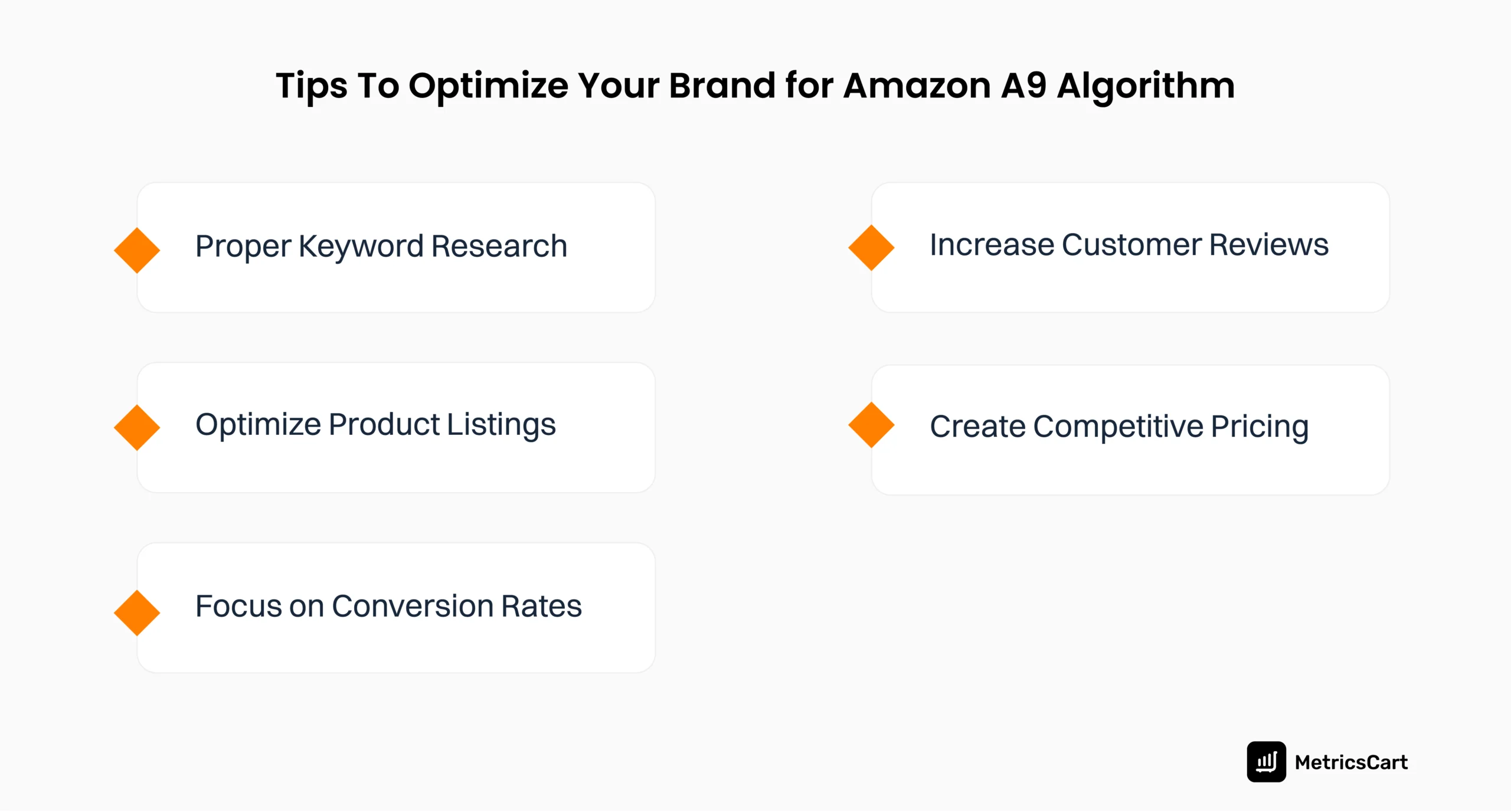
Do Thorough Keyword Research
Your product needs to appear in search results to attract clicks. Use third-party tools like MetricsCart to find the best keywords for your product. Ensure your primary and secondary keywords are strategically placed in your title, bullet points, and backend search terms.
For example, if a consumer is searching for “lights for living room furniture,” then you should have the relevant keywords optimized within the product listings of your brand.
Optimize Your Product Listings
Your product listings need to be clear, professional, and packed with relevant information. Focus on your product title, bullet points, description, and images.
High-quality images and a compelling product description that answers customer questions will help boost conversion rates, which in turn will increase your ranking in the A9 algorithm.
If a consumer is looking for “smartwatches with battery life,” then your product image, description, title, etc., should focus on the aspect of good battery life. This improves your chance to figure out the search results for search queries.
Encourage Customer Reviews
The more positive reviews you have, the better. Implement strategies to encourage satisfied customers to leave feedback. Consider using tools like Amazon Vine or automated email follow-ups to ask for reviews after a purchase politely.
According to Statista, 49% of US consumers had seen some form of fake product reviews on Amazon. Amazon’s A9 algorithm also tries to tackle this hurdle when analyzing a brand or product’s credibility.
So, proper review management and response to negative Amazon reviews can have long-term benefits for brands and sellers.
Positive reviews reduce cart abandonment rates and thereby increasing your brand’s conversion rate.

Maintain Competitive Pricing
Monitor your competitors regularly and adjust your prices accordingly. The A9 algorithm on Amazon favors products that offer good value, and Amazon is famous for its dynamic pricing strategy, which changes prices multiple times a day.
Avoid pricing your product too high, but also don’t undercut yourself. Finding the right balance is key to maintaining profitability while staying competitive.
MetricsCart helps track your and your competitor’s pricing, thereby increasing your chances of creating a better price range that aligns with Amazon’s dynamic pricing strategy.
Focus on Conversion Rate Optimization (CRO)
Conversion rate optimization is a powerful lever for improving your Amazon ranking. Optimizing your product pages to increase the likelihood of purchase through better imagery, clearer descriptions, or improved shipping options signals to Amazon that your product is highly desirable, which boosts your ranking in the algorithm.
READ MORE | Confused about which digital shelf analytics tool to use? Read our blog on the 10 Best Digital Shelf Analytics Software in 2024
Conclusion
Winning the Buy Box is crucial for increasing sales and visibility, especially in a crowded marketplace like Amazon, where millions of sellers flourish or wither away on a daily basis.
Consumers mostly prefer convenience over brand loyalty, so brands and sellers should make themselves visible on the radar of a consumer searching for products on Amazon.
By paying attention to key factors such as competitive pricing, fulfillment methods, and seller performance metrics, you can increase your chances of dominating the Buy Box.
Need help optimizing your Amazon listings? An all-rounder digital shelf analytics software will help you track your brand performance, monitor competitor pricing, and make effective data-driven decisions.
Ready To Revolutionize Your Brand’s Future?
FAQ
Sales velocity directly impacts your ranking on Amazon because the A9 algorithm favors products that sell quickly and frequently. The faster your product moves, the more likely Amazon will prioritize it in search results.
Amazon’s A9 algorithm prioritizes products with competitive pricing to ensure customers get the best deal. Compared to similar listings, overpriced products will likely be deprioritized in search rankings.
Backend search terms allow you to include hidden keywords that A9 uses to index your product. They help improve your product’s visibility by capturing related searches, misspellings, and synonyms that potential buyers might use.





